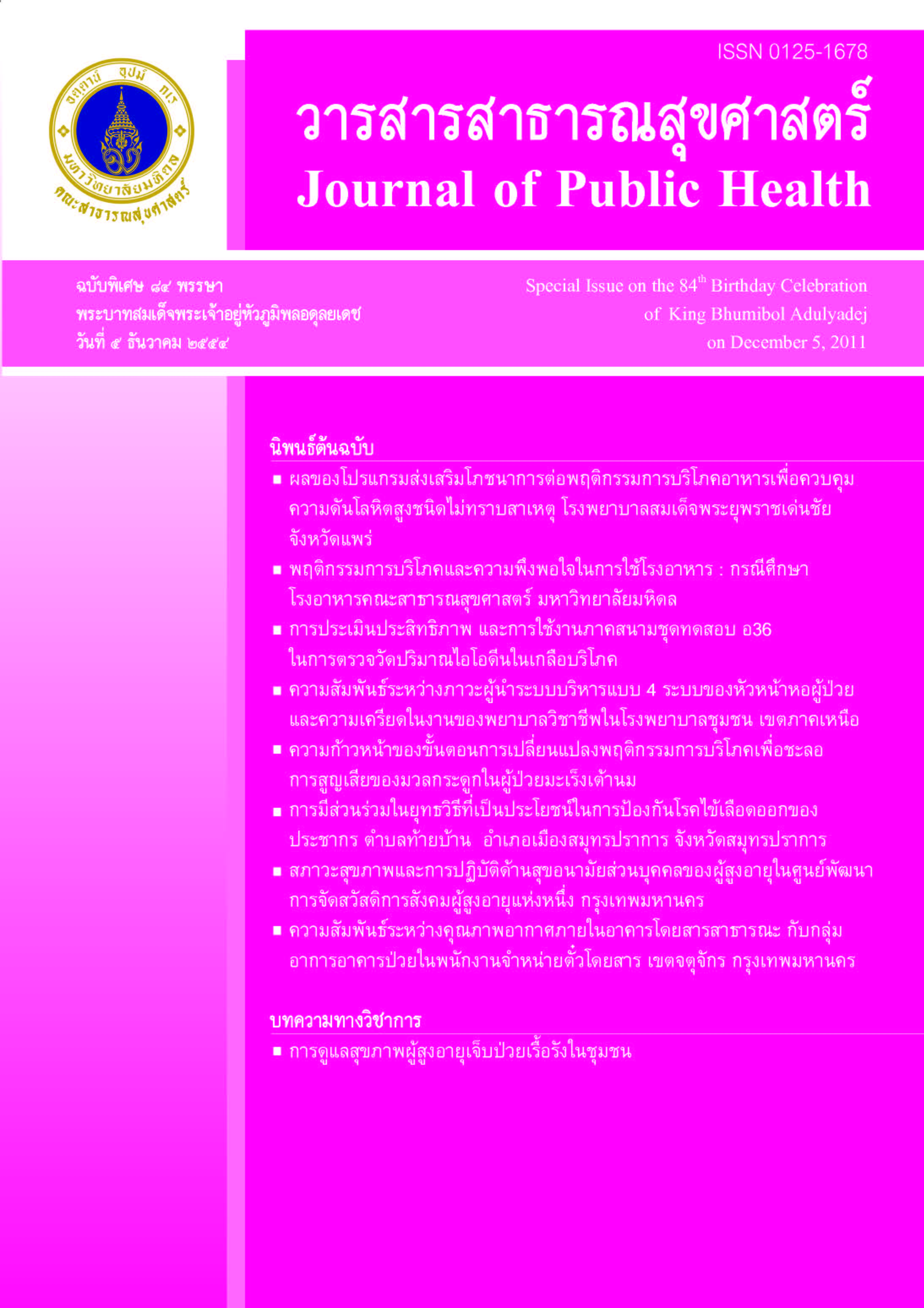ความสัมพันธ์ระหว่างคุณภาพอากาศภายในอาคารโดยสารสาธารณะ กับกลุ่มอาการอาคารป่วยในพนักงานจำหน่ายตั๋วโดยสาร เขตจตุจักร กรุงเทพมหานคร
Keywords:
อนุภาคฝุ่นขนาดเล็กกว่า 10 ไมครอน, เชื้อรา, เชื้อแบคทีเรีย, คุณภาพอากาศภายในอาคาร, กลุ่มอาการอาคารป่วย, Particulate matter less than 10 microns, Fungi, Bacteria, Indoor air quality, Sick building syndromeAbstract
บทคัดย่อ
การศึกษาแบบภาคตัดขวางนี้ มีวัตถุประสงค์เพื่อศึกษาความสัมพันธ์ระหว่างคุณภาพอากาศภายในอาคารโดยสารสาธารณะกับกลุ่มอาการอาคารป่วยในพนักงานจำหน่ายตั๋วโดยสาร โดยเก็บตัวอย่างอากาศเพื่อตรวจวัดปริมาณอนุภาคฝุ่นขนาดเล็กกว่า 10 ไมครอน (PM10) จำนวน 34 ตัวอย่างปริมาณเชื้อแบคทีเรียและเชื้อราอย่างละ 136ตัวอย่างและปริมาณความเข้มข้นของก๊าซคาร์บอนไดออกไซด์และก๊าซคาร์บอนมอนอกไซด์ อย่างละ 68 ตัวอย่างในบริเวณช่องจำหน่ายตั๋ว และเก็บข้อมูลโดยใช้แบบสอบถามเกี่ยวกับอาการที่เกิดขึ้นขณะที่พนักงานจำหน่ายตั๋วโดยสารปฎิบัติงานมีผู้เข้าร่วมโครงการ 219 คน วิเคราะห์ข้อมูลด้วยสถิติเชิงพรรณนาและทดสอบความสัมพันธ์โดยใช้สถิติ Chi-square test
ผลการศึกษาพบว่า ค่าเฉลี่ย ปริมาณ PM10 ในอากาศบริเวณช่องจำหน่ายตั๋วเท่ากับ 90.1±15.5 μg/m3ค่าเฉลี่ยปริมาณแบคทีเรียเท่ากับ 212.3±129.3 cfu/m3 ปริมาณเชื้อราเท่ากับ 54.5±4.5 cfu/m3 และปริมาณความเข้มข้นของก๊าซคาร์บอนไดออกไซด์และก๊าซคาร์บอนมอนนอกไซด์มีค่าเฉลี่ยเท่ากับ 745.4±236.1 ppm และ 19.7±1.9 ppmตามลำดับ กลุ่มอาการอาคารป่วยในพนักงานที่พบ คือ อาการปวดศีรษะ (ร้อยละ 87.7) อาการคัดจมูก (ร้อยละ 81.7)อาการระคายเคืองตา (ร้อยละ 72.6) อาการคล้ายโรคหอบหืด (ร้อยละ 69.4) และอาการระคายเคืองผิวหนัง (ร้อยละ60.3) และเมื่อนำมาหาความสัมพันธ์ระหว่างคุณภาพอากาศกับกลุ่มอาการพบว่า มีความสัมพันธ์กันอย่างมีนัยสำคัญทางสถิติ (p < 0.05) คือ อาการระคายเคืองตามีความสัมพันธ์กับปริมาณของฝุ่น PM10 (p = 0.047) อาการปวดศีรษะมีความสัมพันธ์กับปริมาณความเข้มข้นของก๊าซคาร์บอนไดออกไซด์และปริมาณความเข้มข้นของก๊าซคาร์บอนมอนนอกไซด์ที่ตรวจพบ (p = 0.037) และ (p < 0.001) ตามลำดับ
คำสำคัญ : อนุภาคฝุ่นขนาดเล็กกว่า 10 ไมครอน; เชื้อรา; เชื้อแบคทีเรีย; คุณภาพอากาศภายในอาคาร; กลุ่มอาการอาคารป่วย
ABSTRACT
The aim of the study was to evaluate the relation between indoor air quality and Sick Building Syndrome ofticket sales staff by gathering up 34 samples of air to examine the quantity of particulate matter less than 10 microns,136 samples of bacteria and fungus and 68 samples of the intensive of carbon dioxide and carbon monoxidein the area of ticket sales boxes. The questionnaire related to sick building syndrome was used to survey 219participations of ticket sales staff working in the terminals and analyzed, using descriptive statistics andchi-square test.
The result of the study demonstrated that the average of particulate matter in the area of ticket salesboxes was 90.1±15.5 μg/m3, the average of bacteria and fungus quantities were 212.3±129.3 cfu/m3 and 54.5±4.5cfu/m3, the average of the intensive of carbon dioxide and carbon monoxide were 745.4±236.1 ppm and 19.7±1.9ppm. The headache (87.7%), nasal manifestation (81.7%), eye irritation (72.6%), throat and lower respiratorytract symptoms (69.4%) and skin problem (60.3%) were found in Sick Building Syndrome of ticket sale staff.To value the relation of air quality and symptoms, it was found that there was a relation with significant statistics(p<0.05) including eye irritation relating to particulate matter (p=0.047), headache related to the intensive ofcarbon dioxide and carbon monoxide examined (p=0.037) and (p<0.001) sequentially.
Key words: Particulate matter less than 10 microns; Fungi; Bacteria; Indoor air quality; Sick building syndrome
Downloads
Issue
Section
License
Creative Commons License CC-BY-ND


